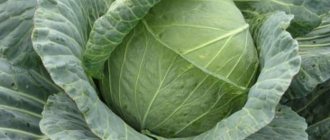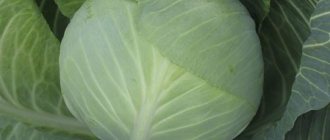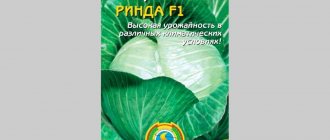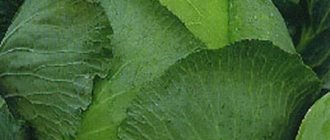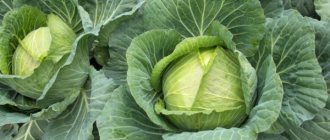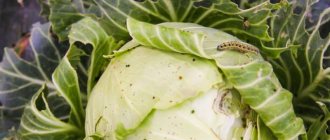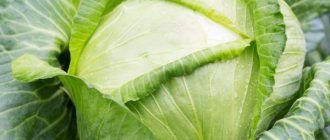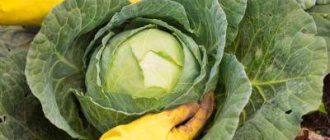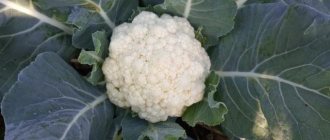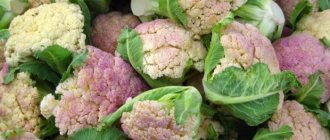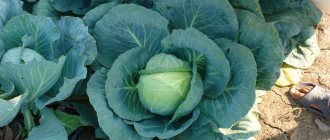For home gardens and commercial cultivation, the high-yielding Atria cabbage is ideal. The description of this hybrid attracts both farmers who grow vegetables on an industrial scale and summer residents who plant several rows on their plots.
Late-ripening cabbage Atria F1 was bred by a Dutch company. It was included in the state register of seed products of the Russian Federation in 1994. The variety is suitable for consumption not only fresh, but also for long-term storage.
Description of the hybrid
Atria cabbage has rounded heads. Sometimes there are a rounded-flat shape. The forks are large and leveled. Their average weight is 5-8 kg, but individual specimens can grow up to 10 kg. The heads of cabbage have a greenish-white color when cut. The inner stump is very short.
The rosette is small, compact, slightly raised. The leaves are dark gray-green in color. There is practically no bubble on them. The shape of the leaves is oval, they are wide, not wavy. The middle vein is concave and has a light greenish tint. Anthocyanin color is present. The waxy coating is strong.
How and when to plant?
Seeds for seedlings are planted already in April, it is better to do this at the end of the month; this technique is used in almost all regions except the southern ones. There you can plant seeds directly into the ground. This hybrid matures in 140 days, so it is worth adjusting its planting in advance.
Video shows how to plant cabbage:
Artria seeds must be hardened and tested for germination. The first method also acts as a prevention of various cabbage diseases:
- The purchased seeds are placed in water for a quarter of an hour, the temperature of which should reach 50 degrees.
- After a minute, the liquid is drained and the planting material is placed in cold water.
- After five minutes of exposure, the seeds are soaked for 12 hours in a prepared solution of 5 grams of nitroammophosphate and 1 liter of water.
- Then the seeds should be washed with fresh water and left in a cold room for a day, at a temperature of 1-2 degrees. But you can read in the article how and when to plant Peking cabbage for the middle zone.
It is worth understanding how to water cabbage with boric acid and how effective this product is.
It will also be useful to learn more about what folk remedies exist for cabbage pests, and which of them are the most effective.Maybe
Pros of a hybrid
Description of Atria F1 cabbage will be of interest not only to farm owners, but also to amateur gardeners with little experience in growing. This hybrid is absolutely unpretentious to climatic conditions and soil fertility. The vegetable is resistant to pests and various diseases. Its heads of cabbage are very juicy, which makes the product universal. Its use has a wide range.
Cabbage can be preserved for six months without any problems. But if all conditions are met, it will last until next summer. At the same time, Atria is convenient to store. It is able to withstand putrid environments. Even when deformed, the heads of cabbage do not lose their properties and qualities. Moreover, cabbage improves its taste during storage.
The specimens have high density and uniformity. This simplifies the transportation process. Vegetables ripen at the same time, which is convenient for their collection and further processing.
The hybrid is characterized by stable yield, resistance to cracking, as well as excellent taste and good transportability. Atria cabbage has a pleasant presentation, which plays an important role when growing it for sale.
Recommendations for cultivation
There are two ways to propagate cabbage - seedlings or seeds. Each of them has its own advantages and disadvantages. Seeds can be planted directly into the soil only in the southern part of Russia; in other regions it is better to use seedlings.
Seeds
The easiest way is to buy seeds in a store, since collecting them yourself is very difficult. Cabbage blooms only in the second year of life, after which green fruits with seeds appear.
Planting of seed begins in early April. The day before, the seeds are soaked in a weak solution of potassium permanganate or in the preparation “Fitosporin”. After a day, the seeds can be planted.
You can use a universal primer or make your own mixture. To do this, take turf, sand, and peat in equal parts. The seeds themselves are planted in rows to a depth of 1 cm, with a distance of 3 cm maintained between plantings.
Attention! You should not use soil from the garden, as it may be contaminated with fungal spores and pest larvae.
If you still have to take soil, then it needs to be calcined in the oven or soaked in a manganese solution.
Cons of Atria
Having presented the description of Atria F1 cabbage and its positive qualities, it is necessary to note some nuances. They cannot be called disadvantages, but it is important to know the main points of care. This hybrid loves moisture very much; it is worth watering the plants regularly. This is especially true for August. The water should be warm. After watering, it is necessary to loosen the soil and hill up. For growth, you can use fertilizers based on mineral compounds, and for protection against pests - special preparations. The area of the plot for Atria cabbage should be open, spacious and not shaded.
Advantages and disadvantages of the variety
Atria cabbage, like any other variety, has its pros and cons. Among the positive qualities are:
- excellent taste when fresh;
- excellent density of heads of cabbage at the stage of technical maturity;
- low degree of gray mold damage;
- uniform ripening of the crop;
- long shelf life;
- resistance of heads of cabbage to cracking.
As for the shortcomings, there are none as such; most likely these are features of agricultural technology. Atria F1 is very moisture-loving, which indicates the need for regular watering, and with warm water.
Video: review of Atria cabbage variety
Agricultural technology
Sowing of seeds begins in mid-April. The planting depth is 1-2 cm. If you follow the sowing plan of 50x50 cm, then it is possible to get a high yield, which reaches up to 10 kg per 1 sq. m. m. After 25 days, 2-3 leaves appear. When there are more than five of them, you can transfer the seedlings to open soil. This happens around the end of May. The fruits are considered ripe on the 140th day after full germination.
Late-ripening variety Moscow late
Late-ripening Moscow late cabbage grows to truly gigantic sizes. Read more about the variety...
Growing Atria cabbage is not at all difficult. Doesn't take much effort or time. But it gives amazing results: high yield, marketable appearance and pleasant taste. Try this hybrid in your garden and share the results with us. Undoubtedly, they will be great, because the reviews about Atria F1 cabbage are only positive.
Planting and care
Two methods are used to grow Atria cabbage: sowing in the ground and planting seedlings. Considering the ripening time of this variety, it is recommended that in the southern regions immediately sow the seeds in a summer cottage, and gardeners in the northern regions should give preference to planting seedlings.
Growing seedlings
In order not to waste time and get good Atria cabbage seedlings, it is better to first make sure that the seeds are germinated. First, the seed material is hardened: kept for 10-15 minutes in hot water, and then immersed in cold water for a minute. At night, the seed material is soaked in a solution of nitroammophosphate and washed in the morning. To ensure the quality of the planting material, it is wrapped in a wet cloth and placed in a warm place for five days. The fabric must not be allowed to dry out, so the fabric is periodically moistened. On the fifth day, you can check the germination of seeds. Unsprouted grains are simply thrown away.
Important! Street soil must be disinfected.
For this, a special composition or solution of potassium permanganate is used. Such a preventive measure will protect the sprouts from infections and diseases.
Growing seedlings is carried out in several stages.
- A fertile soil mixture is prepared. To do this, mix soil, peat, and clean sand. To provide seedlings with nutrition, it is also recommended to add superphosphate and ash.
- Holes (one centimeter deep) are marked on the surface of the moistened soil at a distance of a centimeter from each other.
- Sprouted grains are placed in the holes, covered with earth and pressed lightly. The box can be covered with film and stored in a warm room (with a temperature not lower than +18˚ C).
- Seeds usually germinate in 4-5 days. At this stage of development, the optimal temperature for the growth of seedlings of the Atria variety is considered to be +7˚ C. If this requirement is not observed and the seedlings are left warm, they may die.
- As soon as several leaves appear on the Atria seedlings (in about 9-10 days), you can begin the stage of planting the sprouts in separate pots. A universal option for separate containers is a peat pot.
- The dishes are filled with soil containing mineral fertilizers. To avoid damaging the seedlings when replanting, it is advisable to use a stick or a teaspoon.
- In separate containers, Atria cabbage grows for 19-24 days. Ten days after transplantation, they begin to harden the seedlings. For this purpose, containers are taken outside for a short time. Every day the period of stay of seedlings on the street increases. Immediately before transplanting cabbage into open ground, it should be outside all day.
The most suitable period for planting seedlings in a garden plot is May 10-20. There is no longer a threat of night frosts, and the soil warms up to a suitable temperature.
Advice! It is better to plant Atria seedlings in a greenhouse if you want to get an early harvest or if cabbage is grown in a cold region.
Watering cabbage
For confident growth and high-quality formation of the Atria head, it is recommended to properly water the crop. Cabbage is a moisture-loving plant. Therefore, for some time after planting, the seedlings are watered every two to three days.
After 12-14 days, you can reduce the frequency to once a week.
The Atria variety especially needs regular watering at the head formation stage. In order for the plant to grow normally, it is advisable to use warm water for watering, not lower than +18˚ C.
An important procedure for caring for Atria cabbage is constant loosening of the soil to ensure aeration of the roots.
Advice! It is better to loosen the soil and simultaneously remove weeds before and after watering.
Soil fertilization
To obtain a full and good harvest, Atria cabbage is regularly fertilized. Recommended soil fertilization schedule:
- 20 days after transplanting the seedlings. The Effekton solution is used;
- ten days after the first application of fertilizing. Fertilizer "Kemir" is used;
- June - a mixture of mineral fertilizers (superphosphate and potassium sulfate) is applied;
- August - (about three weeks before harvesting Atria, a solution of nitrophoska is added).
To prevent nutrient mixtures from damaging the cabbage root system, fertilizers are applied to wet soil (it is advisable to choose a cloudy day).
Reviews about cabbage
Even the most skeptical and eternally dissatisfied whining gardeners could not find any shortcomings in Atria F1 cabbage. Therefore, there are only rave reviews about this hybrid. However, judge for yourself.
Afanasy Petrovich, Nizhny Novgorod
I grew different varieties and hybrids of cabbage. But lately my favorites have been Aggressor and Atria. I especially like the last one. The heads are large and elastic. The leaves are succulent and growing well. True, it gains maximum relish after the New Year. But this has its plus. When other cabbage has almost outlived its usefulness, Atria pleases with its sweetness and special cabbage richness.
Valentina, Lviv
We tried this hybrid by accident. In the store I was without glasses and mixed up the packets of seeds. But I decided not to throw it away, since I already grabbed it, but to give it away. We don't regret it. We have soil with a high level of acidity. You have to add ash during the entire growth period of the cabbage. And usually, our heads of cabbage are smaller than what is written on the bags. And this one is just lovely. All heads weigh 3.5 kg or more. I have only seen such a huge cabbage at the market before. And this year all the neighbors ran to see what kind of miracle I was growing. So next year my variety is only Atria.
Olga Nikolaevna, Grigoriopol
No matter what anyone says, I have been using only Dutch seeds for many years. They are reliable. Good germination and the harvest is exactly what was promised on the package. That’s why I’ve been planting Atria for many years. This white cabbage is tasty, has a long shelf life and is generally not picky. Sometimes it can stand without watering at all for 7-10 days if it is not possible to fill it. Then I slowly/little by little start watering and everything evens out - it doesn’t burst. In general, I love this cabbage.
Harvesting
If you harvest Atria cabbage correctly and provide suitable storage conditions, the heads of cabbage will last well all winter and early spring. A distinctive feature of the Atria variety is that it gains juiciness during storage.
If you do not plan to dig up Atria cabbage, then you will need a sharp knife to cut the vegetable. When harvesting, leave a fruit stalk 3-5 cm high. It is advisable to immediately pluck the lower leaves.
Advice! It is not recommended to leave cut heads of Atria cabbage on bare ground. The harvest is placed on a specially spread film.
To ensure good preservation, vegetables are left in the fresh air for some time - so that the upper green foliage will wilt.
If Atria cabbage is dug up, the root system is immediately thoroughly cleaned of soil. The yellowed lower leaves are torn off. The heads of cabbage are also left in the garden so that the roots and root stem dry out. The optimal way to store vegetables in the basement is to hang a head of Atria cabbage by the root.
To prevent various diseases from developing in the soil, the area is carefully cleaned after harvesting. The roots and basal legs of the heads of cabbage are dug up, and the torn lower leaves are collected.
Important characteristics of the hybrid (table)
| Variety or hybrid | hybrid |
| Ripening time | late-ripening |
| Kochan | round, round-flat, dense |
| Kocheryzhka | short |
| Disease resistance | resistant to major cabbage diseases |
| Fruit weight, g | 4000-8000 |
| Growing areas | the entire territory of the Russian Federation with the exception of the northern regions, Moldova, Ukraine, Kazakhstan, the North Caucasus |
| Disembarkation scheme | 50cm x 50cm |
| From germination to ripeness | 135-150 days |
| Seed placement depth | 1.0-2 cm |
| Seedling age | 50-55 days |
| Soil temperature for planting seeds/seedlings | +4/+10 |
| Advantages | high yield, transportability, smooth ripening, forks are maximally aligned, excellent commercial quality, does not crack, unpretentious in cultivation |
| Flaws | moisture-loving, light-loving, cannot tolerate acidic soil |
Diseases and pests of cabbage
Fusarium is a fungal disease that causes cabbage to wilt. Signs of the disease - the foliage turns yellow and fades. The heads of cabbage are small and deformed. Sick plants must be removed from the site. The remaining cabbage is pollinated with fungicides Benomyl and Tecto. As a preventive measure, it is recommended to carefully remove all plant debris from the soil. It is not advisable to plant cabbage in one area for several seasons in a row.
Turnip mosaic is a virus. Affected vegetables become covered with light green spots. As a result of the disease, cabbage leaves fall off. The virus is carried by harmful insects (aphids, mites). It is useless to fight the disease with insecticides. Therefore, the main attention is paid to prevention: diseased plants are removed along with part of the soil, weeds are carefully pulled out, and Atria seeds must be disinfected before planting.
The main pest of the crop is the cabbage aphid. The insect feeds on cabbage juice and gradually depletes the vegetable. Aphid colonies settle on young cabbage in the spring. To destroy pests, use Karbofos and Iskra. As a preventive measure, you can sow tobacco or plant garlic around the perimeter of the cabbage planting - aphids cannot tolerate strong odors.
Gardeners value Atria cabbage for its unpretentiousness, high yield, good keeping quality, and excellent taste.
Description of Atria cabbage variety
Atria F1 is a hybrid of white cabbage, which is characterized by plastic leaves, good yield and preservation of standing heads. Atria is a medium-late variety that ripens 140–150 days after germination. The head of cabbage has a round or rounded-flat shape. According to the state register, the weight of heads of cabbage is 1.5–3.7 kg, but on seed bags, manufacturers indicate slightly different figures - 4–8 kg. The culture is characterized by resistance to gray rot, fusarium, and thrips.
The weight of heads of Atria cabbage according to the state register is 1.5–3.7 kg, on seed bags the numbers are slightly different - 4–8 kg
The culture tolerates transportation well and is perfectly preserved for 6 months when optimal conditions are created. The variety is suitable for pickling, pickling and fresh consumption. The hybrid can be cultivated almost throughout the entire territory of Russia, with the exception of the northern regions. According to the state register, cabbage of this variety is approved for cultivation in the following regions: North-West, Volga-Vyatka, Central Black Sea Region, Middle Volga, Ural, West Siberian, East Siberian.
Atria F1 is a hybrid of white cabbage and is characterized by good yield and keeping quality
